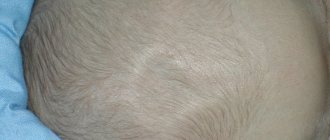Wax plug consists not only of sulfur, but also of separated skin particles, as well as dust.
Earwax discharge in a child's ear is absolutely normal and natural, as it does not allow dirt, bacteria and other harmful microorganisms to get deeper into the inner ear.
But in some cases, the normal production of such secretions is disrupted, and the ear canal is partially or completely blocked. The sulfur plug can have different colors, so we will not post a photo of it - instead, we will attach a diagram of its location.
About wax in a child’s ears: normal and abnormal
The hygiene of your baby’s ears should be given no less attention than other organs and parts of the body. Under normal conditions, wax is released from the ear gradually and in small quantities. It protects the hearing organ from microorganisms and contaminants, and must be removed in a timely manner, taking all precautions.
Should mom worry if the intensity, character, and appearance of earwax secreted from the ear changes? When do these changes become a reason to visit a doctor?
What is considered normal and how to clean your ears
A healthy ear produces yellowish-brown wax. The amount and nature of discharge depend on physiological characteristics: for one person it may be dry light yellow flakes, for another it may be more viscous dark yellow or brown sulfur.
It is recommended to clean your child’s ears as soon as the ear canal and pinna become dirty. Typically cleaning is done once a week:
- for hygienic procedures performed on infants, it is necessary to use small twisted wicks of cotton wool (turunda), previously moistened with oil or a solution of hydrogen peroxide;
- Cleaning the ears of an older child is carried out with special cotton swabs that have a limiter that prevents the instrument from getting deep into the ear - this will protect the hearing organ from accidental injury.
Earwax is removed with careful rotational movements, bending the ear down and slightly back. You should not allow the cleaning object to move forward, so as not to accidentally push the released sulfur into the depths (this can form a cerumen plug) and cause pain to the baby.
Preventive measures
In any case, as with other health problems, prevention is better than cure. Preventive measures are:
- daily gymnastics - pull your earlobes down several times a day;
- gently cleansing the auricle using special children's sticks with a stopper or using a finger wrapped in gauze;
- using drops of A-Cerumen, Remo-Vax 2 times a month to improve sulfur waste;
- ear protection in the swimming pool - cap, headphones, earplugs;
- drying the ear canals with sterile cotton wool flagella if a large amount of water gets there;
- preventive examinations by an otolaryngologist every six months.
Changes in color, density and intensity of sulfur release
Dark color
If the mother notices that noticeably more wax accumulates in the baby’s ears than usual, and its color has darkened (even black), she can assume that a foreign object or dirt once got inside the ear, causing intoxication of the auditory organ.
Read also
Giardiasis in children: effective drugs and treatment regimen for the disease, preventive measures
One-time dark discharge from the ear should not cause concern for parents. Thus, the child’s body, with the help of sulfur, which performs a protective function, gets rid of microorganisms: an insect that accidentally got into the ear or a small foreign object.
A cause for concern is black or dark brown discharge that continues for several days. During a visit to the otolaryngologist, it will most likely become clear that an inflammatory process has begun, and it requires immediate treatment.
Liquid discharge
Parents should also be alerted by the fact that the earwax discharge has become thinner and more intense. At the same time, the baby shows anxiety and often cries, and an older child complains of pain in the ear.
These symptoms indicate the development of otitis, the treatment of which is carried out under the close supervision of a doctor.
Dry sulfur
If earwax has always been viscous and yellow-brown, and then lightens and becomes dry, the mother needs to check the child for skin diseases and allergies. In this case, you will also need to consult a specialist.
Sulfur plug
Earwax is another problem that can occur due to improper ear care, water getting into the ear, or too much wax production.
Signs of its presence:
- Temporary deafness in one ear. A baby does not respond to sounds and voices when lying on its side with the healthy ear pressed against the pillow, while an older child complains of ear congestion or listens to sounds by turning the ear that is not plugged toward the source.
- The wax plug can be seen without special devices - just carefully examine the child’s ear canal.
It is not advisable to get rid of earwax plugs on your own, since inept actions can cause severe pain and deeper pushing of the earwax accumulation inside. It is better if an otolaryngologist professionally performs a painless removal procedure using a special instrument or rinsing the ear.
To prevent the formation of wax plugs, you should periodically clean your ears. You should not allow water to get into your ears while swimming. And if water does get inside, it must be removed by tilting the baby’s head and wiping the sink with a cotton wick.
Why does a child have a lot of dark-colored wax in his ears: causes and solutions to the problem
Sulfur is constantly present in a child's ears. Normally there should be a small amount. When a baby has a lot of sulfur, you need to figure out why this is happening.
It is possible that the cause is not related to the disease and is easily eliminated. In other cases, you will have to undergo treatment. ENT doctors do not advise trying to clear wax from a child’s ear on their own – the risk of injury is too great.
Earwax protects the ear canal from infections, but a large amount of it is dark in color - a reason to consult an ENT specialist
Read also
Rapid labor: first signs and possible serious consequences for the baby and the woman in labor
Why is there wax in the ears?
Ear discharge, or wax, consists of gland secretions, skin particles, sweat and sebum. Their function is to protect the ear canal from dust and dirt, they clean and disinfect the outer ear. Wax prevents water from entering the middle ear. Germs and contaminants enter the ear canal and are expelled back through ear secretions.
Changes in consistency, color, and amount of sulfur depend on the health of the baby. In its normal state, sulfur is dark brown in color and odorless. It comes out of the ears on its own and accumulates at the entrance to the ear canal.
Diagnostic methods
At home, a child’s wax plug can be detected visually by pulling the ear a little and looking inside the ear canal. Cork looks like a light or dark yellow paste-like (honey-like) or plasticine-like mass. Dense sulfur plugs are dark brown or black in color and resemble clods of earth (see photo).
Only an ENT doctor can make a final diagnosis. Using an otoscope, he will examine the ear canals, determine the size and density of the plug, and rule out the presence of fungal infections, tumor-like formations, and foreign bodies.
Reasons for producing large amounts of earwax
When excessive amounts of earwax are produced, the disorder is called hypersecretion. How can you tell if sulfur production is excessive? The child develops a feeling of constant moisture in the ear, and sulfur stains are noticeable on the bed linen and hat.
Why does a child produce a lot of sulfur:
- otitis media, inflammation of the middle ear – often occurs in children under 4 years of age;
- acute respiratory diseases;
- otomycosis, fungal infections;
- the appearance of sulfur plugs;
- hormonal changes in the body during adolescence;
- dermatitis, eczema, allergies in a chronic form, while reddish spots are observed on the auricle and in the ear canal;
- excess cholesterol - this element is part of sulfur and can affect its amount;
- frequent wearing of hearing aids, headphones and other foreign objects in the ears - the nerve endings of the glands become irritated and begin to secrete a large amount of secretion;
- improper ear care, excessive desire for hygiene and constant cleaning of the ears from wax;
- psycho-emotional stress in a child, stress and heavy loads;
- long stay in a dusty, dirty room;
- damage to the ear canal;
- increased secretion in infants from birth.
Concomitant symptoms of ear diseases accompanied by excessive secretion of wax
Symptoms that should alert parents:
- the appearance of itching, burning, color change;
- greenish sulfur mixed with pus flows from the ear - this sign is characteristic of otitis media;
- sulfur discharge has an unpleasant putrid or rotten odor - this indicates infection with staphylococcus;
- an increase in body temperature and general symptoms of intoxication indicate the development of an inflammatory process in the ears;
- pain or feeling of a foreign object in the ear;
- swelling of the mucous membrane and the feeling of fluid flowing inside the ears indicate allergic otitis media;
- dry sulfur is also characteristic of allergies;
- too dark or black-brown color of sulfur occurs with fungal diseases;
- stuffy ears and hearing loss;
- pain in the ear and temple;
- dizziness and nausea;
- blood from the nose;
- obsessive cough.
Read also
Bifiform baby: detailed description of the action of the drug and dosage for children of different ages
If there is excessive wax production, the child will feel constant discomfort in the ear area.
At first, the accumulation of sulfur does not make itself felt. When it completely blocks the ear canal, the child experiences headaches, dizziness, and hearing loss. It is necessary to wash out the wax plug on time, otherwise it may contribute to the development of otitis media.
Signs of a traffic jam
At first, the child’s wax plug does not bother him in any way. The ear begins to bother babies when it closes 70% of the ear canal. Usually problems begin after a large amount of water gets there, for example, when swimming or diving.
The sulfur mass swells and increases in size. Then the child himself helps to identify deviations, if, of course, his age allows him to do this. He complains of noise, ringing, humming, congestion, echoes of his voice in his ears.
Then parents immediately need to be wary and understand why the child’s ears are bothering them; complaints should never be ignored. Not everyone knows what a plug in a child's ear looks like. In fact, it is not difficult to see it for yourself by pulling back your ear and looking inside. We list other signs of the presence of sulfur plugs:
- decreased hearing acuity;
- dizziness;
- pain in the temporal region;
- nausea;
- cough;
- pain when pressing on the ear.
If the child is still small, he will not be able to say, for example, that he has become hard of hearing. Adults themselves will notice that the baby has stopped responding to calls to him, has begun to ask questions often, and flinches when someone appears in the room.
Or he began to constantly touch his ear, rub it, scratch it, and get nervous for no reason. Attentive parents will immediately notice the symptoms of wax plug.
Features of treatment depending on the cause of the symptom
Treatment for excessive wax production depends on what condition your doctor diagnoses and its cause. He will prescribe rinsing of the ear canal, medications, or refer you to other specialized specialists (allergist, dermatologist, endocrinologist, etc.).
Self-medication with folk remedies is not recommended. In young children, cleaning the ear canal on your own can easily damage the eardrum - the consequences can be very serious.
Removing wax plug
Often, when there is excessive wax production, parents use cotton swabs to clean their ears, but this is strictly forbidden. This can easily damage the external auditory canal. When using sticks, the opposite process occurs - sulfur is not removed, but, on the contrary, is pushed deeper and leads to the appearance of even more discharge.
Cleansing takes place in several stages:
- if the cork is too dense, softening is necessary with a 3% solution of hydrogen peroxide, petroleum jelly or glycerin;
- often, after softening, the plug comes out on its own; if this does not happen, rinsing is required;
- after washing, a 3% solution of boric acid is instilled into the ear; for a while, the ear canal must be closed with a cotton swab.
Another way to remove wax plug is to use special drops or solutions (A-Cerumen), which are sold in pharmacies. Modern clinics have new generation devices that carefully and painlessly clean a child’s ear.
Removal with candles
A method of removing traffic jams that has been tested by many generations and has become traditional. In addition to the main effect - cleansing the ear canal, ear candles warm up the entire ear apparatus.
You can remove the traffic jam using them using the following algorithm:
- a person with a blocked ear lies on his side;
- a napkin is placed on the ear, in which a small hole is made;
- the wick of the candle is set on fire, and its bottom is applied to the ear;
- during the combustion process of a candle, the accumulation of sulfur will soften due to an increase in its temperature;
- when the candle burns down to a critical level, it should be extinguished, and the remaining cork should be removed using cotton swabs and napkins;
- A piece of cotton wool is inserted into the cleaned ear for 30 minutes to prevent too sudden cooling;
- if the second ear is congested, the procedure is repeated on it.
Candles can be purchased at any pharmacy at an inexpensive price (usually 30-40 rubles). The method shows an excellent ratio of price and positive effect.
Various variations of methods for eliminating blockage of the ear canal make it possible to cope with the problem on your own. By following the instructions given and choosing the appropriate method for yourself, you can easily restore healthy, full-fledged hearing and get rid of uncomfortable sensations.









